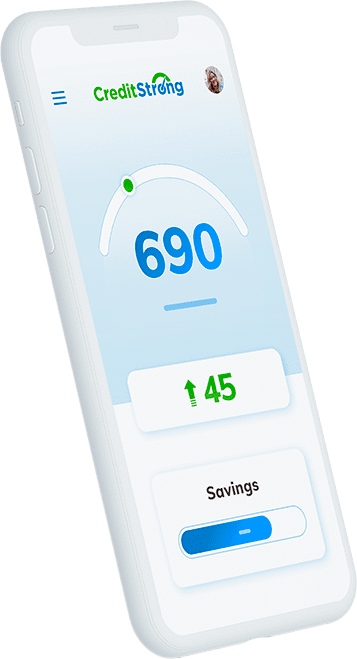How to Get Startup Business Loans with Bad Credit

Build strong business credit
with your EIN
Startup founders often incur significant upfront costs to get their operations off the ground and start generating revenue. As a result, they frequently need external financing to grow initially.
Unfortunately, it’s challenging for new startups to qualify for traditional business loans because they lack business credit. Let’s explore some alternative forms of financing you can use to clear that hurdle and get startup business loans with bad credit.
Startup Business Loans for Bad Credit:
- Online Business Lenders
- Invoice Factoring
- Merchant Cash Advance
- Microloans
- Equipment Financing
- Small Business Credit Cards
- Crowdfunding
- Loans From Friends and Family
- Retirement Funds
- Business Grants
- Personal Loans
Online Business Lenders
Traditional financial institutions have the most rigorous underwriting requirements, including the highest credit score expectations. You’ll usually need good personal and business credit to qualify for an account.
However, online lenders tend to be significantly more flexible. They often have clients with no business credit history and only fair or bad personal credit scores, which start at around 600 for FICO.
For example, Fundbox and OnDeck are two popular alternative lenders that don’t expect applicants to have business credit and only require personal credit scores of 600 and 625, respectively.
For context, the average credit score was 714 in 2021, and a traditional lender usually wants you to have a score of at least 700.
Because online lenders have lower requirements, they can be a viable financing option for business owners with bad credit, but there’s a catch. They tend to offer less favorable terms than banks and credit unions.
Most notably, that includes having higher costs and shorter repayment terms. For example, OnDeck’s term loan starts at 29.9% APR and lasts up to 24 months, while Bank of America’s starts at 7% APR and lasts up to five years.
Invoice Factoring
Invoice factoring isn’t technically a startup business loan, but it’s a great way to generate working capital for companies with bad credit. It involves selling outstanding invoices to a factoring company instead of collecting them yourself.
Factoring is ideal for businesses with cash flow issues due to the extended payment terms they offer their clients. For example, net 30 and net 60 terms commonly cause companies to go weeks or months without getting paid.
Because businesses generally incur costs to provide their products and services, delayed payments often cause negative cash flows and deplete cash reserves. However, factoring lets you liquidate your invoices early, smoothing out your cash flows.
Typically, you receive 70% to 90% of your invoice’s value after submitting it to the invoice financing company. They then become responsible for collecting from your client. Once they do, they’ll return the rest of the invoice value minus a fee.
Because invoice factoring isn’t really a loan, providers aren’t concerned with your personal or business credit scores. As long as you have outstanding invoices to sell, you can usually qualify for the financing arrangement.
Merchant Cash Advance
Merchant cash advances provide a lump sum upfront, like a startup business loan, but they’re much easier to qualify for than accounts from traditional institutions. In fact, they may also be more accessible than term loans from online lenders.
Generally, the qualification requirements include a minimum monthly revenue and time in business but not a credit score. For example, Credibly will give you an advance if you have $15,000 in monthly sales and six months of business history.
Like online loans, the primary downside of merchant cash advances is that they’re expensive. Unfortunately, that problem is especially significant with these accounts. You should usually only consider merchant cash advances as a last resort.
Your costs depend primarily on your factor rate, which usually ranges from 1.1 to 1.5. You then multiply it by your loan amount to calculate your total repayment amount.
For example, if you take out a $40,000 advance with a 1.3 factor rate, you’d have to pay back $52,000, which equals $12,000 of financing costs. You’ll also often incur additional origination fees of around 2% of your proceeds.
The other notable issue with merchant cash advances is that you typically must repay them with automatic daily or weekly deductions from your credit and debit card sales, which constantly erodes your cash flows.
Microloans
Many nonprofit organizations and the Small Business Administration (SBA) offer microloan programs.
The SBA offers many programs to help startups and small businesses get financing. Rather than issue the loans directly, they typically guarantee portions for lenders, reducing the risks those providers face.
Therefore, you might qualify for the average SBA loan a little easier than a traditional unsecured business loan, but only slightly. The lenders involved are still usually traditional institutions and get to set their own underwriting requirements.
However, the microloan program is an exception. Instead of insuring these loans for banks or credit unions, the SBA funds them directly and uses nonprofit community-based organizations with experience in lending to execute the arrangement.
Microloans are also much smaller than typical small business startup loans, with a maximum principal balance of $50,000, though they average around $13,000.
As a result, microloans are easier to qualify for than many traditional business loans, even with a bad credit score. However, you usually need to provide collateral and sign a personal guarantee.
Equipment Financing
If one of your reasons for wanting financing is to purchase new equipment for your business, consider getting an equipment loan. It’s an installment loan that uses the asset you purchase as collateral.
Because it’s a secured business loan, the lender can seize your equipment and sell it to minimize losses if you ever default. That safety net makes the arrangement safer for the lender, and they may be willing to look past your lack of credit.
Keep in mind that equipment loan proceeds usually match the purchase price of your intended equipment. As a result, they typically won’t help you generate any additional working capital.
Like standard installment loans, you can get equipment financing from various providers, including traditional institutions and online lenders.
Once again, your rates will be better with a bank or credit union, but they’ll have higher qualification requirements.
It’s a good idea to shop around with multiple lenders to ensure you get the best rate, but do your research to minimize unnecessary applications, as too many can damage your credit.

Small Business Credit Cards
Business credit cards are another form of financing that most new business owners can qualify for, even if they’ve never had business credit before. Credit card issuers typically let you open an account using your personal score.
You’ll need good credit to qualify for most accounts, but some may still be available if your score is below average. If you’re worried you might fall short, consider applying for a secured account that uses cash as collateral.
Of course, a business credit card isn’t a direct substitute for a startup loan, but it’ll still be highly beneficial for most companies.
First, using a separate revolving business line for your startup’s transactions is the best way to split your personal and business activities. That’s essential for maintaining organized financial records, which you’ll be grateful for come tax time.
Second, spending with a credit card can help you earn some lucrative cashback rewards. The more competitive accounts also tend to include introductory bonuses.
In addition, credit card interest rates are too high to carry a balance for long, but they have an interest-free grace period of about a month. That makes them perfect for short-term financing and smoothing out your cash flows.
Finally, business credit cards are an easy way to lay the foundation for your business credit. They’re financial tradelines, and making your payments on time will help you qualify for a small business loan later.
Crowdfunding
There are several types of crowdfunding, but each one involves gathering relatively small investments from many third parties. It contrasts with standard financing arrangements that only include a single lender or investor.
Equity crowdfunding is the arrangement you might find most familiar. It requires issuing a number of shares to investors, similar to an initial public offering, but for private companies rather than public corporations.
Debt crowdfunding is the other traditional approach to crowdfunding. It works similarly to a standard installment loan, but multiple individuals contribute to your proceeds rather than a single lender. However, you still only have to make one monthly payment.
Finally, rewards-based funding is a relatively new form of financing that’s gaining popularity. Contributors receive samples of your products or services, so you maintain ownership of your company and avoid taking on debt.
Business owners typically complete their crowdfunding campaigns through digital platforms like Kickstarter or Fundable, which generally don’t check your credit. However, they usually take a significant portion of your proceeds.
For example, Fundable charges 5% of your total funds raised and 3% plus $0.20 per contribution, or 5% plus $0.05 for any below $10.
Loans From Friends and Family
If you don’t have the credit to get financing using traditional means, it may be worth going to your friends or family for assistance. They may be more inclined to give you the benefit of the doubt than a lender due to your personal connection with them.
In addition, you can usually leverage your relationship to get better terms than you would from a lender, such as a lower interest rate, longer loan term, or a smaller monthly payment.
Whatever terms you agree to, it’s best to get them in writing, even if you have a casual relationship. Conduct the affair as professionally as possible to minimize the chances of miscommunication and minimize the personal fallout if you can’t pay.
Of course, there’s only so much you can do to avoid straining the relationship if you can’t live up to your promises, so be careful. If the loan is going to be high risk, it may be better to wait until your credit improves and search for alternative business funding.
Retirement Funds
You typically can’t take funds out of a traditional retirement account like a 401(k) until you’re 59 ½ years old without incurring a 10% penalty. However, there are some exceptions that may let you tap into your funds early and use them for your business.
Typically, the easiest way to do that is to borrow against your account. You can generally take a 401(k) loan for the lesser of $50,000 and 50% of your vested balance.
If you go this route, you won’t have to pay early withdrawal penalties or taxes on your proceeds. However, it’ll function like a legitimate loan, which means you’ll need to pay back your balance plus interest, generally within five years.
While that sounds convenient, it’s another funding option that should usually be a last resort. Borrowing from your 401(k) can significantly compromise the growth of your account balance, delay your eventual retirement, or lower your future lifestyle.
Defaulting on a 401(k) loan by failing to repay it within five years is even worse, as you’ll become liable for the 10% penalty and ordinary income taxes on the withdrawal.

Business Grants
A business grant is a lump sum that a governmental entity gives to a business, usually to accomplish something specific. They’re an outright gift, so you don’t have to pay the amount back or give up any ownership of your company in exchange.
That makes them highly desirable, as they’re essentially free money. It also means that your personal and business credit scores are irrelevant since the provider doesn’t need to worry about whether or not you’ll pay them back.
Unfortunately, qualifying for a grant is still challenging. Not only is the application process intensive, but you’ll often need to prove that you meet some unique eligibility requirements to qualify.
Remember, grants are usually for a specific cause, such as scientific research or supporting veteran-owned businesses. Providers design their eligibility requirements to ensure their funds go to the right place.
For example, the SBA provided the Shuttered Venue Operators Grant to talent representatives and operators of live venues during the COVID-19 pandemic, such as museums, performing arts organizations, and motion picture theaters.
Fortunately, there are many different grants available to small businesses. Some of the best places to look for them are with large corporations, nonprofits, the SBA, your state, and the federal government.
Personal Loan
Business loans are generally more effective tools than personal loans for financing a startup. They tend to have lower interest rates, higher principal balances, and longer repayment terms.
However, personal loans are still a surprisingly effective option, especially for a new small business owner. You’ll need a good personal credit score to qualify for favorable terms, but you won’t need any business credit history.
Shopping around is essential to getting the best offer, but keep your applications within a 14-day window to minimize the damage to your FICO score. That way they’ll only count as a single hard credit check.
Before applying for any accounts, double-check that the provider allows borrowers to use their proceeds for business purposes. Many lenders are okay with it, but some won’t be, and trying to deceive them isn’t worth the risk.
Of course, personal loans don’t do anything to build business credit, which you’ll need if you ever hope to qualify for more conventional business financing in the future. If you go this route, consider getting a business credit card to get at least one financial tradeline.
How To Figure Out Which Option Is Best for You
There’s no universally ideal form of business financing, especially if your lack of credit limits your options. However, you can usually figure out the best option for you without too much difficulty.
Start by determining which accounts you can realistically get with your qualifications. Lenders typically consider your time in business, monthly revenues, and personal or business credit score.
You won’t always know each prospective lender’s specific requirements, but you can get a pretty good idea of what they’re looking for by exploring online.
Next, figure out which accounts you can realistically afford. If you have poor credit, it’s likely that many will be too expensive for your cash flow to support. These aren’t worth applying for, as taking on debts you can’t repay is worse than having no funding.
At this point, you should have only a handful of options remaining. Pick the type of financing you believe gives you the highest chance of qualifying for the most favorable terms. Shop around with multiple providers to get the best quote.
If you don’t qualify for an acceptable offer, repeat the process with the second option on the list or consider delaying your applications until your credit scores improve.
CreditStrong for Business is the only 0% interest business credit builder in the nation
